Yoga On-the-Go: 7 Yoga Poses You Can Do Anywhere
Summer has finally arrived on the East Coast, and these seasonal transitions are a good time to review and refresh our commitment to self-care. If you’ve been browsing my website, you know that I practice yoga asana, pranayama, meditation and Bodymind Ballwork, a myofascial release technique. And in summer I look forward to adding in hiking, swimming, gardening, and playing outdoors with grandchildren. Plus one of my favorites – just lying in the grass and watching the sky. So the idea of what is “exercise” can expand beyond the normal routine.
What does your self-care look like? Perhaps you attend a yoga class or a meditation group, or go to the gym, or do some exercise at home. Does it change with the seasons? Can you throw in something new from time to time to keep it playful and fresh? Whether you’re in your twenties, your eighties, or somewhere in between, you may find that there is an ebb and flow to what your body likes to do. Aging is a reality for all of us, the body changes gradually but inevitably, and it’s important to adapt our practice to the fluctuations that are built into being human.
I encourage my students to try variations of yoga poses that they can do at in-between moments in the day – at the office, at home, or while travelling – to remind the body and mind to stay connected and to be fully present in the body for whatever you do. Here are some that I do at my kitchen table, while waiting at an airport, or on a break during a long drive. No need to change clothes, have a yoga mat, or even take off your shoes. Stretch in each direction: forward, backward, sideward and twisting. Be creative with your use of props (a park bench, the side of your car, etc) and also with the sequence – do what feels good to you.
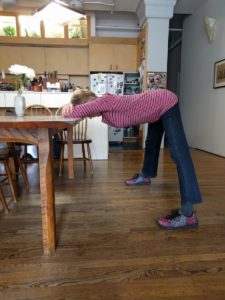 Prasarita Padottanasana: With feet spread wide apart, stretch your legs and reach your hips back as you stretch your torso forward. Rest your head on the table with your arms folded. Breathe and quiet your mind as you connect with sensations inside.
Prasarita Padottanasana: With feet spread wide apart, stretch your legs and reach your hips back as you stretch your torso forward. Rest your head on the table with your arms folded. Breathe and quiet your mind as you connect with sensations inside.
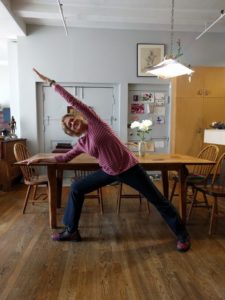 Parsvakonasana with your back to the table: With your right leg turned out parallel to the table, bend the right knee, pointing it toward the middle toes. The other hips shifts forward slightly, away from the table. Lean to the right with the right arm on the table. Keeping your legs and abdomen strongly active, bring your torso to the side as far as you wish. Stretch your left arm alongside your head, reaching vigorously from hand to foot. Repeat on the other side.
Parsvakonasana with your back to the table: With your right leg turned out parallel to the table, bend the right knee, pointing it toward the middle toes. The other hips shifts forward slightly, away from the table. Lean to the right with the right arm on the table. Keeping your legs and abdomen strongly active, bring your torso to the side as far as you wish. Stretch your left arm alongside your head, reaching vigorously from hand to foot. Repeat on the other side.
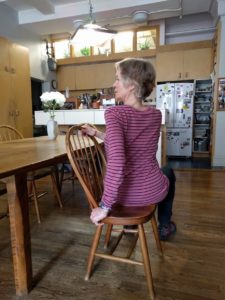 Seated twist with chair: Sit sideways in the chair, with your spine erect and legs steady. Inhale, lift your spine, and exhale, twist toward the back of the chair. Place your hands wherever it helps you to twist more. Hold for a few breaths, and repeat on the other side.
Seated twist with chair: Sit sideways in the chair, with your spine erect and legs steady. Inhale, lift your spine, and exhale, twist toward the back of the chair. Place your hands wherever it helps you to twist more. Hold for a few breaths, and repeat on the other side.
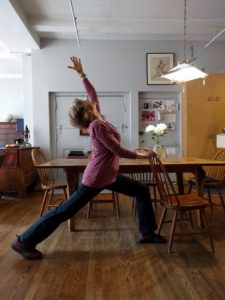 High lunge with the chair: Face the back of the chair and step your right foot forward, your left foot back. Both legs are parallel and the back heel will be off the floor. Face your pelvis squarely toward the chair, and hold the back of the chair with your hands. Lean forward a bit and push into the back leg, widening inside your pelvis and hips. Then pull down through the back of the pelvis as you lift up in the front torso. Raise your chest, look up, and expand from the top of your head all the way to the back foot. Raise your left arm up, and possibly also your right arm. Enjoy your strong and expanded self, then release and repeat on the other side.
High lunge with the chair: Face the back of the chair and step your right foot forward, your left foot back. Both legs are parallel and the back heel will be off the floor. Face your pelvis squarely toward the chair, and hold the back of the chair with your hands. Lean forward a bit and push into the back leg, widening inside your pelvis and hips. Then pull down through the back of the pelvis as you lift up in the front torso. Raise your chest, look up, and expand from the top of your head all the way to the back foot. Raise your left arm up, and possibly also your right arm. Enjoy your strong and expanded self, then release and repeat on the other side.
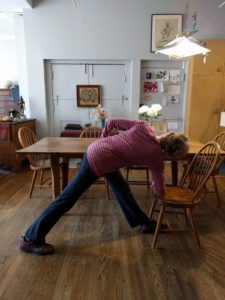 Parivrrta Trikonasana with the chair and tabletop: Place the chair sideways next to the table, the seat facing you, as shown. Step your left leg forward and keep both legs straight. Reach your hips back and your chest forward as you place your right hand on the chair seat. Twist toward the table, with your left hand pressing down into the tabletop to help empower your twist. Breathe several times, then come out of the twist and repeat on the other side.
Parivrrta Trikonasana with the chair and tabletop: Place the chair sideways next to the table, the seat facing you, as shown. Step your left leg forward and keep both legs straight. Reach your hips back and your chest forward as you place your right hand on the chair seat. Twist toward the table, with your left hand pressing down into the tabletop to help empower your twist. Breathe several times, then come out of the twist and repeat on the other side.
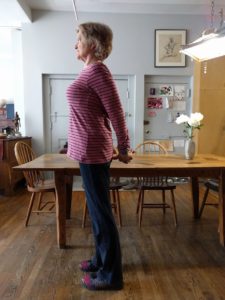 Shoulders and arms pulling back: Stand tall, roll your shoulders back and clasp your hands behind you. Pull your arms back to find a stretch in the front of your shoulders, and a supportive strength in the upper back. Take several deep breaths, feeling all inner sensations as you hold the pose.
Shoulders and arms pulling back: Stand tall, roll your shoulders back and clasp your hands behind you. Pull your arms back to find a stretch in the front of your shoulders, and a supportive strength in the upper back. Take several deep breaths, feeling all inner sensations as you hold the pose.
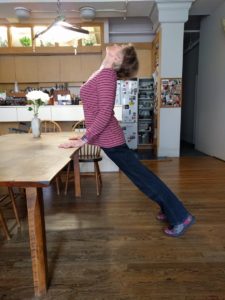 Upward facing dog with hands on the table: Place your hands on the edge of the table and walk your feet back. As you bring more weight onto your arms, be sure to keep your shoulders back and your chest lifted. Bend your elbows a bit, bring your pelvis toward the table with your tailbone lengthening, and move your chest forward between your arms, as if going through a doorway. Look up if you can, and enjoy a full stretch from your chin to your toes.
Upward facing dog with hands on the table: Place your hands on the edge of the table and walk your feet back. As you bring more weight onto your arms, be sure to keep your shoulders back and your chest lifted. Bend your elbows a bit, bring your pelvis toward the table with your tailbone lengthening, and move your chest forward between your arms, as if going through a doorway. Look up if you can, and enjoy a full stretch from your chin to your toes.
Then repeat the first pose, Prasarita Padottanasana, one more time to finish.
I invite you to leave a comment below…. and enjoy the summer.
I am excited to announce my new book, “The Bodymind Ballwork Method: A Self-Directed Practice to Help You Move with Ease, Release Tension, and Relieve Chronic Pain” to be released in October 2018 by North Atlantic Books. You can pre-order your copy now. Click here.

 This time of year gets busy, whatever holidays you do or do not celebrate. Year-end tasks, family visits, shopping, changing seasons, school events – it can be overwhelming. We all need some self-care, but we think we don’t have time. My message to you is: YOU DO HAVE TIME – perhaps just 10-15 minutes a day – and it will pay off with more centeredness to go about your day and your week.
This time of year gets busy, whatever holidays you do or do not celebrate. Year-end tasks, family visits, shopping, changing seasons, school events – it can be overwhelming. We all need some self-care, but we think we don’t have time. My message to you is: YOU DO HAVE TIME – perhaps just 10-15 minutes a day – and it will pay off with more centeredness to go about your day and your week.